Edit: BlockBeats
Since the beginning of 2023, artificial intelligence (AI) has become a new highland in the field of technology, especially driven by ChatGPT, the AI technology trend has rapidly spread globally. This trend has not only triggered an "AI arms race" involving global technology giants, but also reshaped the development trajectory of the technology industry. For practitioners in the Web3 industry, the combination of AI and Web3 is no longer a distant concept, but a clear and feasible development direction.
In the past year, the concept of "Web3 + AI" has rapidly become a hot topic in the industry. In this process, an industry consensus has gradually formed: "blockchain solves the problem of production relations, while AI solves the problem of productivity." This is not only a precise overview of the integration of the two major technological fields, but also heralds the combination of Web3 and AI as an important trend in future technological development. Among the 12 global incubation projects announced by Binance Labs in the sixth season, QnA3, as an "AI-driven Web3 knowledge platform and investment research and trading tool," is a representative Web3 DApp closely integrated with AI.
BlockBeats has analyzed the development of QnA3 and sorted out the technical paths and theories of each stage.
Development Path of QnA3
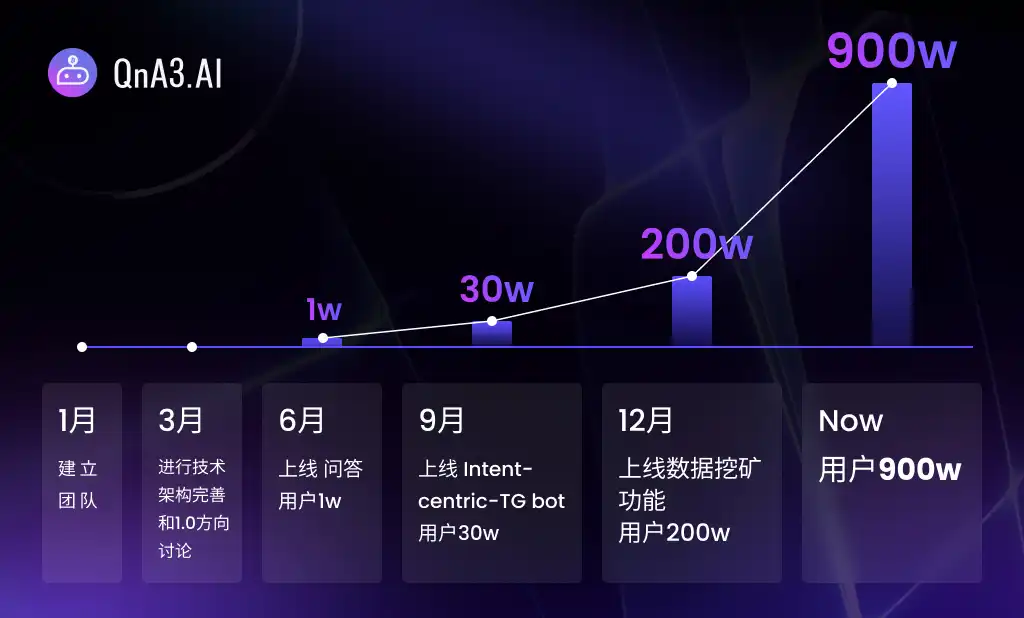
The QnA3 team was established in January 2023 and achieved a huge transformation of its product from 0 to 1 within a year: in June, QnA3 launched the Q&A function, with the user base exceeding 10,000; in September, QnA3 launched a Telegram bot centered on intent, with the user base exceeding 300,000; in December, QnA3 launched data mining function, and QnA3's daily active user count dominated BNB Chain No.1 for over half a month, with the user base exceeding 2 million. Today, the number of QnA3 users has soared to 9 million.
Core Positioning of QnA3: AI Agent Necessary for Residents of the Web3 World
According to the official introduction, QnA3 is an AI Agent necessary for residents of the Web3 world, assisting users in the full-lifecycle, all-scenario management of Web3.
1) Information Management AI+Research = "RAG"
QnA3 is a leader and all-around player in AI+search in the Web3 field.
Based on GPT fine-tuning models and search engines such as Google and Microsoft Bing, QnA3, compared to generative AI models like ChatGPT, has professional data and proprietary knowledge barriers, strong timeliness of information, traceable sources, and effectively reduces illusions. Compared to traditional search engines like Google, QnA3's answers are free of redundant information, accurate and reliable, questions can be broken down, and answers can be provided with feedback.
Relying on rich experience in understanding and applying LLM (Language Model), Pre-Train, Post-Train, Scaling Up, and Inference [1], QnA3 organically combines LLM with search. Its excellent product capabilities, engineering capabilities, and rapid iteration capabilities enable QnA3 to take the lead from behind and consolidate its leading position among many pioneers. The information management function can already meet the needs of conceptual questions, real-time questions, inference questions, market analysis questions, and trading questions in different scenarios.
The core technology principle of taking the lead from behind: maximizing the use of Retrieval Augmented Generation (RAG) technology, while meeting the "professionalism of Web3 knowledge," "high real-time performance," and "strong relevance of Q&A content."
In the early days of the project, QnA3 analyzed the general large models represented by ChatGPT, believing that one of the main problems with LLM is poor timeliness of content (the 3.5 version of ChatGPT released by OpenAI in early 2023 can only collect data up to September 21), and there is also a potential illusion risk due to the lack of indexing.
Essentially, LLM cannot generate content outside of training data and corpora, nor can it provide precise indexing and reference for generated content. The approach QnA3 takes is to learn from Meta. In 2020, Meta researchers introduced RAG to hand over facts related to questions to LLM for processing and learning, not only combining the prior knowledge of generative models, but also drawing on the real-time and rich content of retrieval models.

Principle of Retrieval Augmented Generation (RAG) technology [2]
Retrieval Augmented Generation (RAG) technology consists of two parts: retrieval and generation.
Retrieval system (Retriever): The retrieval process includes a query encoder and a document index. Two different BERT models encode the demand q and the document z into q(x) and d(z), and then use the maximum inner product search algorithm to obtain the document with the maximum inner product, which is then input together with the demand into the generation part.
Generation system (Generator): In this part, the generator summarizes and outputs the final answer based on the retriever. The large model predicts the probability of the next word based on the input and generates the word with the highest probability. There are two ways to calculate the generation probability: 1) RAG-Sequence: using the same document for prediction, first determine the document and then calculate the probability of candidate words; 2) RAG-Token: using different documents for prediction, the probability of each candidate word is the sum of the conditional probabilities of all documents.
QnA3 uses RAG as the core technology of AI+Research. With over ten years of data experience, it has maintained a leading position in three important indicators: retrieval capability, response speed, and data source quality. By using RAG to integrate external knowledge bases with prior model knowledge, the rich and easily updatable data in external knowledge bases effectively compensates for the lag and illusion disadvantages of large models.
2) Asset Management AI+Trading = "AI Agent with Intent-Centric"
Trading is an unavoidable part of the lives of all residents of the Web3 world. Based on the concept of "intent-centric" proposed by Paradiam, QnA3, combined with the interaction between users and AI, has gained several insights:
1) The establishment of user intent is gradual, but the initial intent is vague, and even inaccurate.
2) The accuracy of intent directly determines the user's final experience, and this is largely determined by intent recognition.
3) The simpler, faster, and safer the implementation path that matches the user, the better.
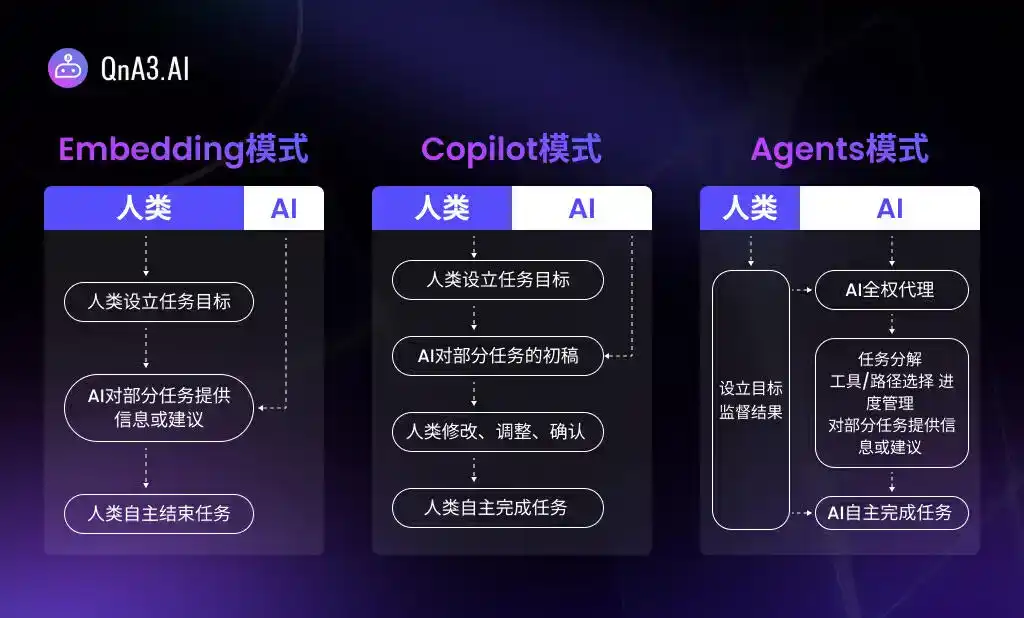
The mainstream scientific community divides the cooperation between humans and AI from primary to advanced into three modes: Embedding, Copilot, and Agents. In the Copilot mode, work is led by humans, and some tasks are assisted by AI, while in the Agents mode, AI fully demonstrates "intelligence" and can exhibit stronger task decomposition, tool selection, and progress control capabilities. Humans only need to set goals, provide resources, and supervise results, and the specific implementation of the work can be fully entrusted to AI agents, that is, "intent-centric."
When implementing the intent-centric system framework, Lilian Weng, the head of the OpenAI security team, proposed that in autonomous agent systems based on large models, LLM serves as the core controller, acting as the brain of the AI Agent with reasoning capabilities, while the other three key components - Planning, Memory, and Tool Use - empower LLM to perform more complex tasks [3]. This aligns with the design approach of the AI Agent in QnA3 when implementing Intent-Centric [4].
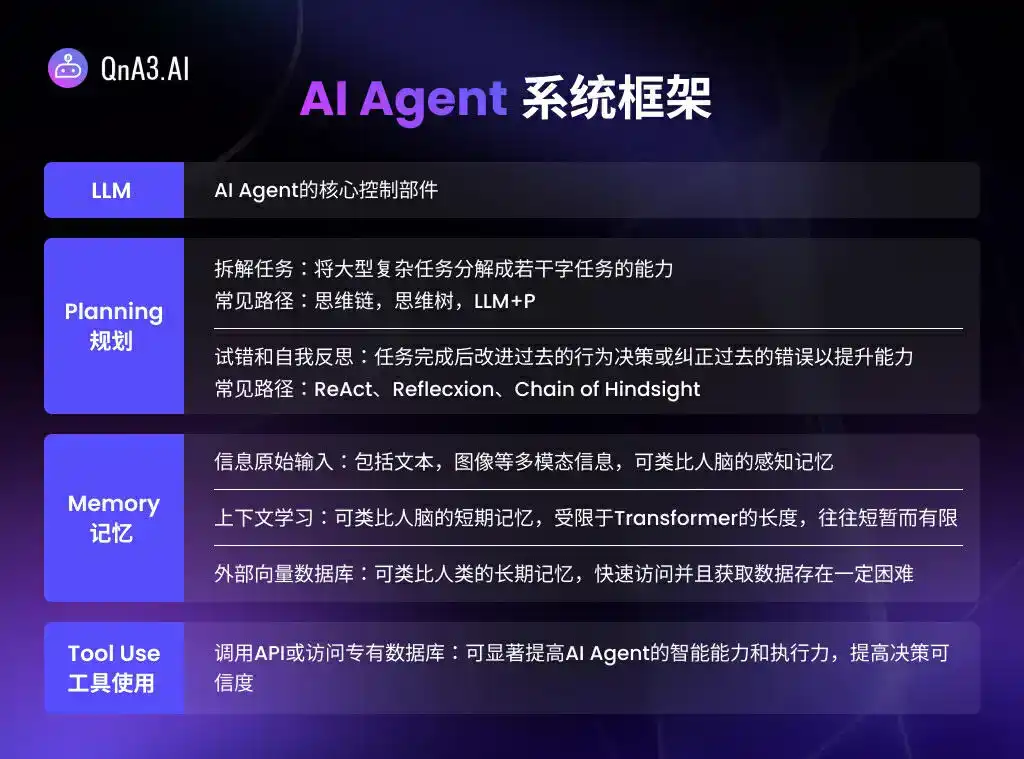
After completing the information management work, QnA3 launched token technical analysis and trading functions, solving the complexity of cross-product and multi-operation between user information and trading. It enables users to seize market opportunities immediately after obtaining information and complete transactions in the most cost-effective, lowest slippage, shortest path, and safest manner through algorithms.
Based on recent months of user experience and feedback, the QnA3 AI Agent designed with "intent-centric" capabilities has already demonstrated the ability to take action, helping users accomplish multiple specific tasks from information management to asset management, with users only needing to set goals and wait for results. It is evident that both ChatGPT and QnA3 exhibit excellent performance in text understanding and reasoning capabilities, providing detailed answers to user queries. However, in the vertical track, QnA3 gains a competitive edge through RAG. Moreover, the action-capable QnA3 can replace users to achieve "help them do" AI+Trading.
3) Rights Management AI+DePIN = "Decentralized Machine Learning"
To further enhance the development level of Web3, there are two basic consensus in the current market:
1) More Web2 users must be introduced and converted.
2) Connection with the real economy must be established.
The growth of DePIN in 2023 has had a significant impact on the Web3 ecosystem. As the boundaries of DePIN expand, it demonstrates qualifications to become a consumer-facing application layer, similar to DeFi, gaming, and social media, with the potential for large-scale adoption, which can drive demand for underlying chains or ecosystem consumers.
Paul Veradittkit, a managing partner at Pantera Capital, mentioned in his blog that the growth trend of DePIN also has downstream effects on decentralized governance. Currently, most DAOs, such as Uniswap, Compound, and MakerDAO, are almost entirely related to digital or financialized assets. As DePIN projects mature and gradually hand over governance to DAOs, the demand for DAO coordination in purchasing, using, and maintaining physical equipment (whether servers, sensors, or hard drives) will continue to increase. DePIN may become a trend that extends the governance rights of DAOs from digital assets to physical assets, ultimately requiring DAO operations and behaviors to be more like traditional companies, which may mark a turning point in the adoption of "Web3" in the "real world" [5].
Upon its product release, QnA3 served as a bridge between the Web2 and Web3 worlds in the form of Q&A. While introducing tens of thousands of Web2 users, QnA3 continues to explore more ways to connect the two worlds.
Inspired by the DePIN trend, QnA3 recently launched data mining functionality, utilizing the idle computing power of decentralized physical devices for AI model training and providing passive income to users through Web3 world incentive mechanisms, completing the closed loop of "user-contributed computing power," "computing power output data training model," and "better model serving users." The AI+DePIN approach chosen by QnA3 integrates the decentralized hardware layer with the community's new data economy.
From Messari's perspective, DePIN is essentially a combination of off-chain data generation and on-chain data confirmation, with the core being rights confirmation and economies of scale. Additionally, DePIN has several modes, such as custom dedicated hardware, like Helium, or a dedicated incentive layer, transforming or adding commonly used hardware to the Web3 network, such as Render Network, which allows individuals to sell their idle GPUs to others [6].
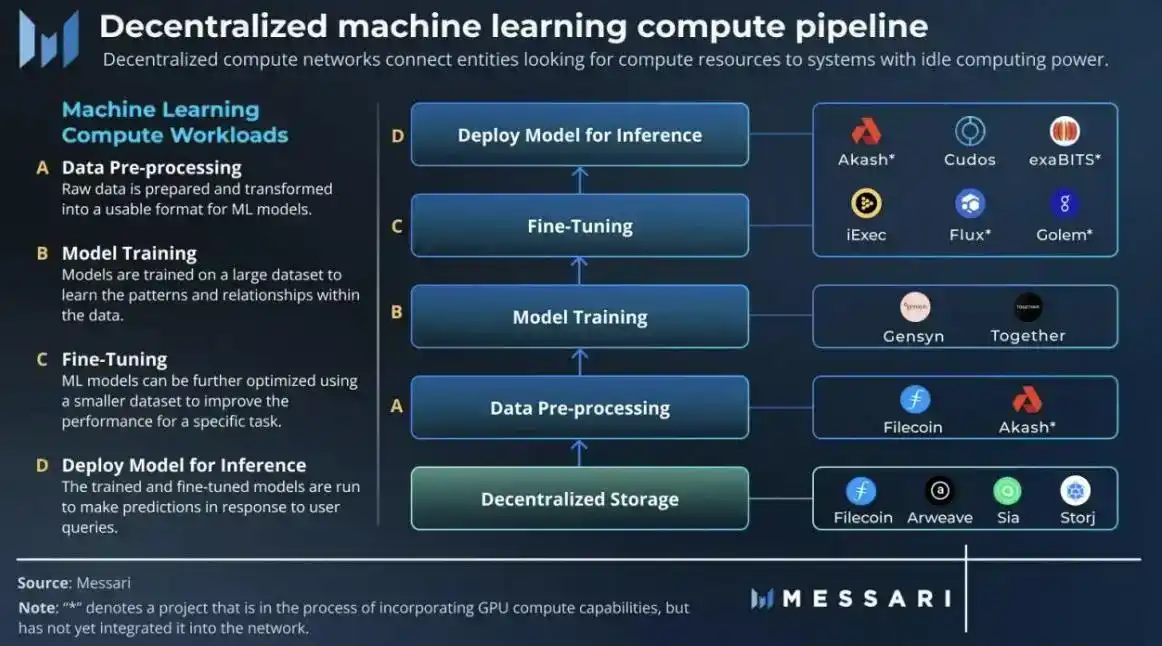
The three key factors of AI+DePIN are:
1) Scalability: The hardware specifications of DePIN will affect the number of computing power providers and the speed of expansion.
2) Adoption Convenience: Reducing friction is key to attracting more computing power providers.
3) Token Economics: Designing and adjusting token economics for stakeholders.
Through the AI+DePIN model, QnA3 leverages user computing power to assist in data acquisition and cleaning. Simultaneously, QnA3 believes that the value of data must be emphasized in the rights confirmation of hardware ownership, and individuals as the subjects of data need new digital rights. This is the value orientation behind DePIN, rather than just on-chain data and token incentives. Combined with actual business, QnA3 ultimately chose the direction of Decentralized Machine Learning. AI projects will always face computational bottlenecks and limitations in collaboration. By combining AI with DePIN, QnA3 is expected to gradually address these issues.
The current attempts are just the first step taken by QnA3 in the application scenario of Decentralized Machine Learning. In the future, QnA3 also plans to introduce more flagship products such as hardware wallets and desktop robots, thereby building a service matrix covering research, trading, and DeFIN with AI at its core, forming a product framework with the AI Agent at its core, covering information management, asset management, and rights management, meeting users' full-lifecycle, all-scenario needs.
Three Major Advantages of QnA3
Research-Driven
QnA3 is a product with a strong AI research foundation in the Crypto projects. QnA3 collaborates with renowned research institutions such as Stanford University, University of California, Berkeley, and Northwestern University, and will soon jointly publish academic papers in top journals. It has a technical advisory committee comprising all-star lineups from OpenAI, Google DeepMind, Meta, Apple, Nvidia, and others. The founding team is mainly based in the United States, with rich experience in data, AI, and crypto from Tencent, Baidu, and internationally renowned investment banks.
User-Oriented
With an understanding of users and market acumen, within six months of its product launch, QnA3 has achieved several critical version iterations. Especially during periods of frequent updates, new features are introduced almost every week, with significant features released every two months. The information management function can already meet the needs of conceptual questions, real-time questions, inference questions, analysis questions, trading questions, price questions, and other scenarios. The asset management function identifies user intent and assists users. The rights management function will gradually realize the digital management of user rights and human rights in the future, truly embodying user-centered product practices.
Functional Innovation
The product iteration speed is fast, with a small version released every week and a major version every two months. Looking at the timeline, from project initiation to product launch, it took less than three months, and within six months of its launch, it garnered 9 million users, covering 166 countries and regions globally, with a daily UAW close to 200K, and has consistently ranked first on the BNB chain.
Future Potential of QnA3
New Modes of Human-Machine Interaction
The rapid growth in QnA3's user base validates the rigid demand for conversational search engines. Positioned as a Web3 vertical product, QnA3 has data and scenario advantages compared to giants like Google and ChatGPT, making it easier to achieve a closed-loop scenario for the AI Agent.
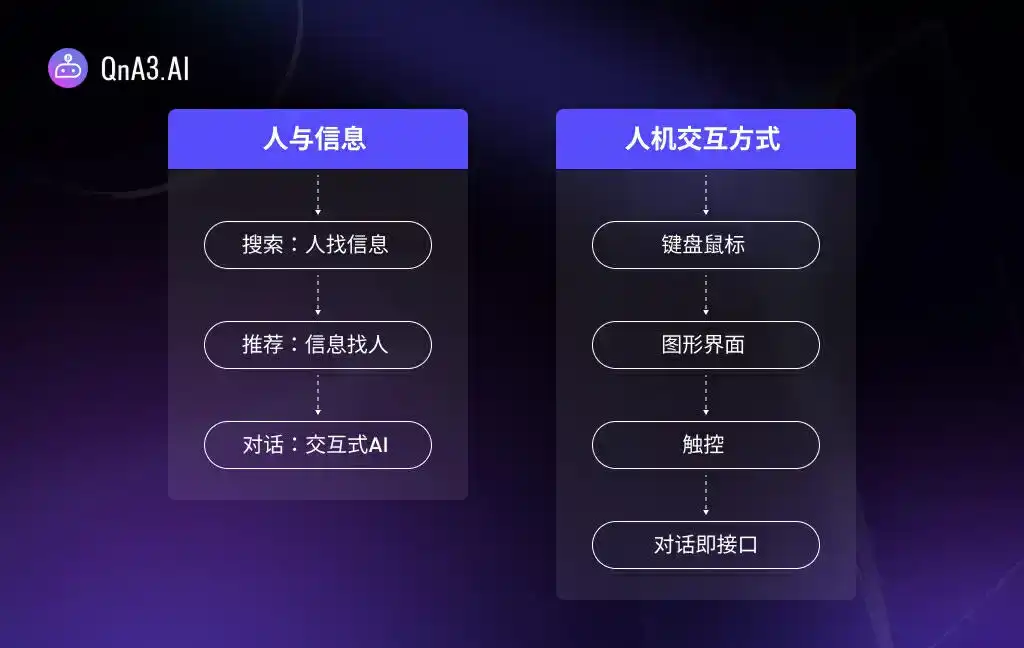
Currently, human-machine interaction mainly relies on graphical interfaces and touch interactions, but in the future, QnA3 could become an entry point at the operating system level, realizing a new human-machine interaction paradigm of "conversation as interface," potentially bringing about new forms of software services.
Commercialization of Productivity Leapfrogging from Production Tools
AI serves as both infrastructure and a productivity engine, akin to steam engines, electricity, computers, and the internet. Under AI empowerment, numerous application software will transition from production tools to productivity, participating in the distribution of production value. Tools like QnA3 will gradually evolve from "production tools" that assist human efficiency to independent incremental "productivity," potentially directly participating in the distribution of value-added income. In the future, the model of AI applications being a part of "productivity" can be measured from the perspective of efficiency improvement "take rate."
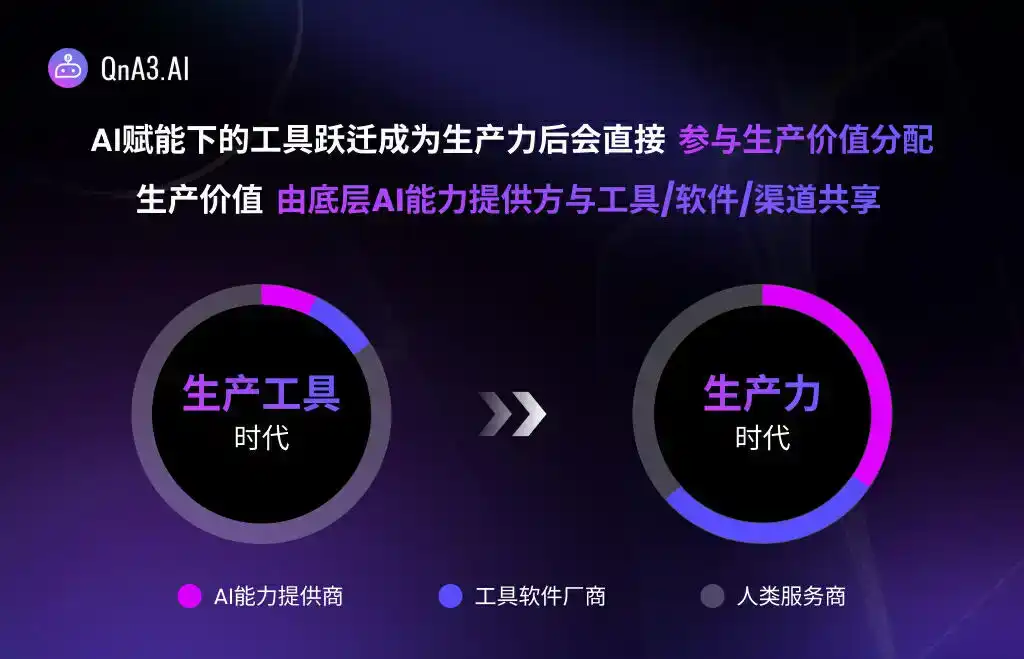
The Telegram bot launched by QnA3 can help KOLs manage communities and facilitate Q&A, token analysis, and token trading within the community, completing a commercial closed loop from the outset. Additionally, QnA3 has partnered with media, exchanges, and training websites. QnA3 states that this ecosystem sample and commission model differ from the business model of exchanges and trading bots, as they are not interested in commissions but in aligning with user goals to become a community of interests, thereby participating in the distribution of value-added income.
QnA3's Two Partners: OpenAI & Google
Compared to OpenAI
QnA3 vs ChatGPT has the following core advantages:
1) Proprietary data and knowledge barriers
Many high-value, specific industry sectors rely on rich proprietary datasets. AI solutions for these niche industries require training on these datasets. However, entities that own these databases will focus on protecting their data moats and are unlikely to allow unrestricted access to these databases for AI training by third parties. Therefore, these entities will establish specialized AI systems for these workflows internally or through specific partnerships. These systems will be different from general AI models.
2) Timeliness of information
Large models like ChatGPT only contain data and corpora from the training period, and subsequent information cannot be updated in a timely manner. QnA3, developed based on traditional search engines, has the advantage of strong timeliness.
3) Ease of traceability
The content generated by QnA3 is accompanied by reference links, ensuring reliability while facilitating user traceability or in-depth research.
4) Mitigating illusions
The illusion problem of general large models is unacceptable in pursuit of high-quality in niche industries. QnA3 has exclusive data sourcing and screening mechanisms to circumvent this problem through multiple processes.
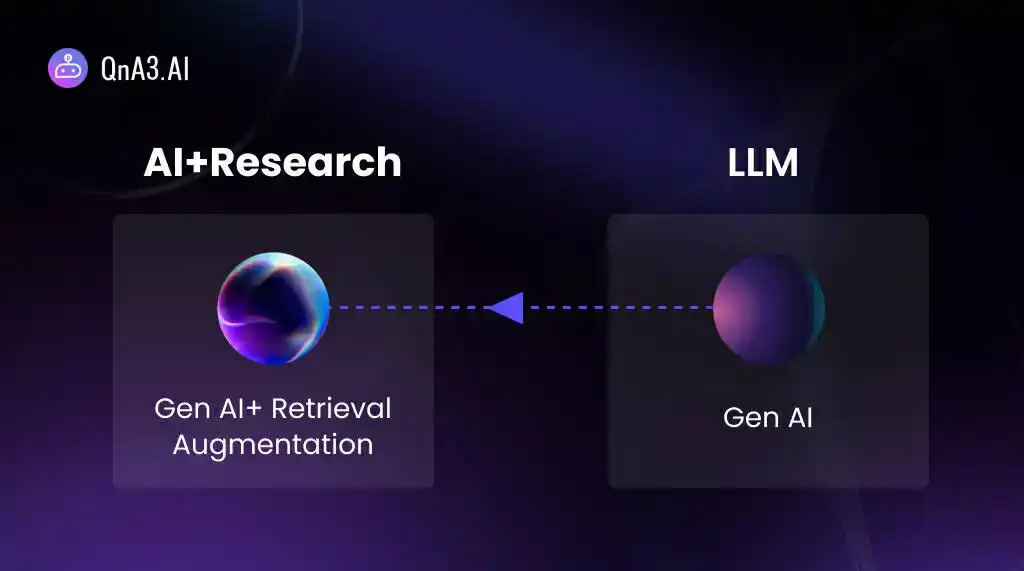
Comparison of AI+Research with Large Model Technology
Generative AI language understanding and generation capabilities are outstanding, but they have disadvantages such as illusions and lack of real-time data. Generative AI is a machine learning model based on AI technology that learns from massive training data and generates entirely new content similar to the original data based on its features, including images, videos, music, speech, and text. In recent years, the improvement in computer hardware performance and the development of pre-training techniques have enabled a leap in generative AI capabilities. Large language models like ChatGPT have strong language understanding and diverse generation capabilities, widely used in various industries. However, generative AI cannot achieve real-time updates and may not cover relatively niche, non-generalizable long-tail knowledge. Additionally, generative AI has poor control over generated content, leading to "illusion" issues, making it difficult for users to directly verify answers.
Retrieval Augmentation Generation (RAG) integrates external knowledge with model prior knowledge, effectively compensating for the shortcomings of generative AI. Retrieval Augmentation Generation (RAG) consists of retrieval and generation. It first retrieves the most matching document content from the knowledge base based on the demand, then inputs it as a prompt to generate an answer.
5) Professionalism as the core of quality
Workflow requirements in niche industries demand high quality and reward any quality improvement actions. Any AI solutions applied to niche industries need continuous adjustments to improve quality. Response speed and feedback efficiency are crucial for quality. The high compatibility of general models will lead to quality gaps here. It can be imagined that if a rocket's AI model is replaced by a general model like GPT-4, the result would be catastrophic. This quality gap will inevitably lead to specialized adjustments.
Compared to Google
QnA3 vs traditional search engines like Google has the following core advantages:
1) Clean pages, direct answers
When entering a question, traditional search engines present multiple parallel links, interspersed with numerous ads, while QnA3 combines the most relevant links to directly generate concise answers. This improves information retrieval efficiency, reduces keyword queries, filtering, link clicks, and page browsing, allowing Web3 users to directly understand the truth in a noisy market environment and a vast amount of information, and make decisions through clear and personalized answers.
2) Fine-grained search in niche fields
As a Web3 knowledge base and AI+Research tool, QnA3 allows users to perform precise searches in Web3 niche fields, yielding more targeted results.
3) Question breakdown and follow-up capabilities
Based on the understanding capabilities of large models, QnA3 can progressively break down and follow up on user queries, accurately understanding user needs. Google can handle questions like "what" and "why" types adeptly. However, for more complex questions such as "Is a certain token worth buying at its current development stage," "Please conduct a technical analysis of token XX," "Compare the pros and cons of BTC and ETH," QnA3 will clearly provide better answers than Google. QnA3's engine has a more powerful ability to understand, summarize, and expand questions, undoubtedly giving it a stronger competitive edge.
4) Feedback function
After generating an answer, users can provide feedback on its accuracy, helping reinforce the model's accuracy through a reinforcement learning feedback mechanism. QnA3 interacts with users on-chain through a points system.
In the Web3 field, there is a big difference between being able to do something and doing it well. After its first search product, Google developed a huge product matrix over decades, including Android, Gmail, and Maps. OpenAI also announced the launch of GPT Store at last year's developer conference. Currently, Google has a market value of $1.7 trillion, and OpenAI is valued at nearly a trillion dollars. QnA3 has proven itself among a large number of Web3 users through its core product. Looking at long-term development, QnA3 will definitely make a significant impact in the Crypto+AI field.
[1] "Torch, Key, Bridge, and Future" Link
[2] Lewis, Patrick, et al. "Retrieval-Augmented Generation for Knowledge-Intensive NLP Tasks." ArXiv abs/2005.11401 (2020): n. pag.
[3] "LLM Powered Autonomous Agents" Link + CICC Research Department
[4] "Above Intent, Below Behavior" Link
[5] "DePIN: Decentralized Hardware Meets the New Data Economy" Link
[6] Messari, "crypto-theses-for-2024" Link
免责声明:本文章仅代表作者个人观点,不代表本平台的立场和观点。本文章仅供信息分享,不构成对任何人的任何投资建议。用户与作者之间的任何争议,与本平台无关。如网页中刊载的文章或图片涉及侵权,请提供相关的权利证明和身份证明发送邮件到support@aicoin.com,本平台相关工作人员将会进行核查。




